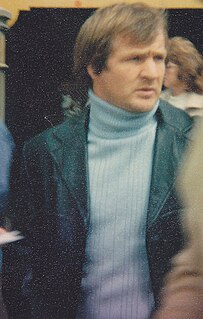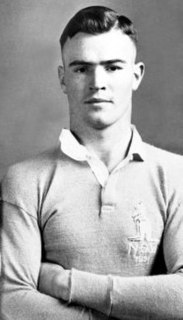
Tommy Raudonikis was an Australian rugby league footballer and coach. He played 40 International games and World Cup games as Australia representative halfback and captained his country in two matches of the 1973 Kangaroo tour.

Ed "Tedda" Courtney (1885–1957) was a pioneer Australian rugby league footballer and coach. He played club football for North Sydney, Western Suburbs and representative football for the New South Wales state and Australian national sides. He is considered one of the nation's finest footballers of the 20th century.

Frank Burge was one of the greatest forwards in the history of rugby league in Australia. Later Burge became one of the game’s finest coaches. His club career was with Glebe and the St. George Dragons. He represented New South Wales on twenty-six occasions and played thirteen test matches for the Kangaroos and played for Australia in a further twenty-three tour matches.

Arthur 'Pony' Halloway (1885–1961), was a pioneering Australian rugby league footballer and coach. Born in Sydney, New South Wales he played for the Glebe Dirty Reds (1908), Balmain Tigers and Eastern Suburbs (1912–1914), in the New South Wales Rugby Football League premiership. He played for New South Wales in the first rugby match run by the newly created 'New South Wales Rugby Football League' which had just split away from the established New South Wales Rugby Football Union.

Victor John Hey, also known by the nickname of "The Human Bullet", was an Australian rugby league national and state representative five-eighth and later a successful first-grade and national coach. His Australian club playing career commenced with the Western Suburbs Magpies, and concluded with the Parramatta Eels. In between he played for a number of clubs in the English first division. He is considered one of Australia's finest footballers of the 20th century

Sidney Charles Pearce, better known as Sandy, was a pioneer Australian rugby league footballer and boxer. He is considered one of the nation's finest footballers of the 20th century. In 1907 he played for New South Wales in the first rugby match run by the newly created 'New South Wales Rugby Football League' which had just split away from the established New South Wales Rugby Football Union. He made his first national representative appearance in 1908.
Ron Coote AM is an Australian former representative rugby league player whose club career was played with South Sydney and the Eastern Suburbs Roosters, with both of whom he won premierships. He is considered one of the nation's finest footballers of the 20th century. Ron Coote Cup, contested annually by South Sydney Rabbitohs and the Sydney Roosters is named in his honour - his entire club career having been played at these two clubs.
Les Cubitt was an Australian representative rugby league player, a centre, or five-eighth whose club career was with Eastern Suburbs and the Glebe. He is considered one of the nation's finest footballers of the 20th century.

Raymond Ernest Stehr was an Australian rugby league footballer, a state and national representative player whose club career was played at Sydney's Eastern Suburbs club. He has been named as one of the nation's finest footballers of the 20th century.

Sid 'Joe' Pearce was an Australian rugby league footballer who played in the 1930s and 1940s. An Australian international and New South Wales representative second-row forward, he played his club football for Eastern Suburbs with whom he won the NSWRFL Premiership in 1935, '36, 37 'and '40. Son of fellow Australian Rugby League Hall of Famer, Sandy Pearce, he is considered one of the nation's finest footballers of the 20th century.

Ernest James Norman was an Australian rugby league player - a state and national representative centre or five-eighth. His club career was with the Eastern Suburbs club in the New South Wales Rugby Football League competition. Norman played with Easts for nine seasons between 1931 and 1939. He played over 100 matches for that club and was a member of the Easts sides that won consecutive premierships in seasons 1935, 1936 and 1937.
Viv Thicknesse (1910–1986) was an Australian dual-code rugby half-back, a state representative in both rugby league and rugby union. His rugby league career was spent with the champion Eastern Suburbs sides of the 1930s and he represented Australia in that code in seven Tests.
Andrew McLaren Norval was an Australian professional rugby league footballer, a national and state representative lock-forward whose club career was with Sydney's Eastern Suburbs club.

Keith Victor Holman, MBE was an Australian Rugby League footballer, a national and state representative Halfback whose club career was played with Western Suburbs from 1949 to 1961.

Arthur James Summons was an Australian representative rugby union and rugby league player, a dual-code rugby international fly-half or five-eighth. He captained the Australian national rugby league team in five undefeated test matches from 1962 until 1964 and later also coached the side.

John Beaton was an Australian rugby league player, a national representative of the 1930s whose short but brilliant club career was played with Sydney's Eastern Suburbs club. He has been named amongst the nation's finest footballers of the 20th century.

Jim Craig (1895–1959) was an Australian rugby league footballer and coach. He was a versatile back for the Australian national team. He played in 7 Tests between 1921 and 1928 as captain on 3 occasions and has since been named amongst the nation's finest footballers of the 20th century. Craig was a player of unparalleled versatility. It is known that he represented in Tests at fullback, centre, halfback and hooker with some of his club & tour football played at winger, five-eighth and lock forward. Whiticker's reference reports that the great Dally Messenger regarded Craig as the greatest player Messenger ever saw.

Frank McMillan was an Australian rugby league footballer and coach. He was a full-back for the Australian national team and played in nine Tests between 1929 and 1934, two as captain. McMillan has since been named amongst the nation's finest players of the 20th century.

Howard Hallett (1890–1970) was an Australian rugby league footballer and coach for South Sydney of the New South Wales Rugby League premiership. Hallett primarily played at fullback. He represented for New South Wales and Australia and is considered one of the nation's finest footballers of the 20th century
Kelvin Joseph "Kel" O'Shea was an Australian representative rugby league footballer, a second-rower from Queensland whose club career was played with the Western Suburbs Magpies in Sydney. He is rated among the nation's best players of the 20th century.